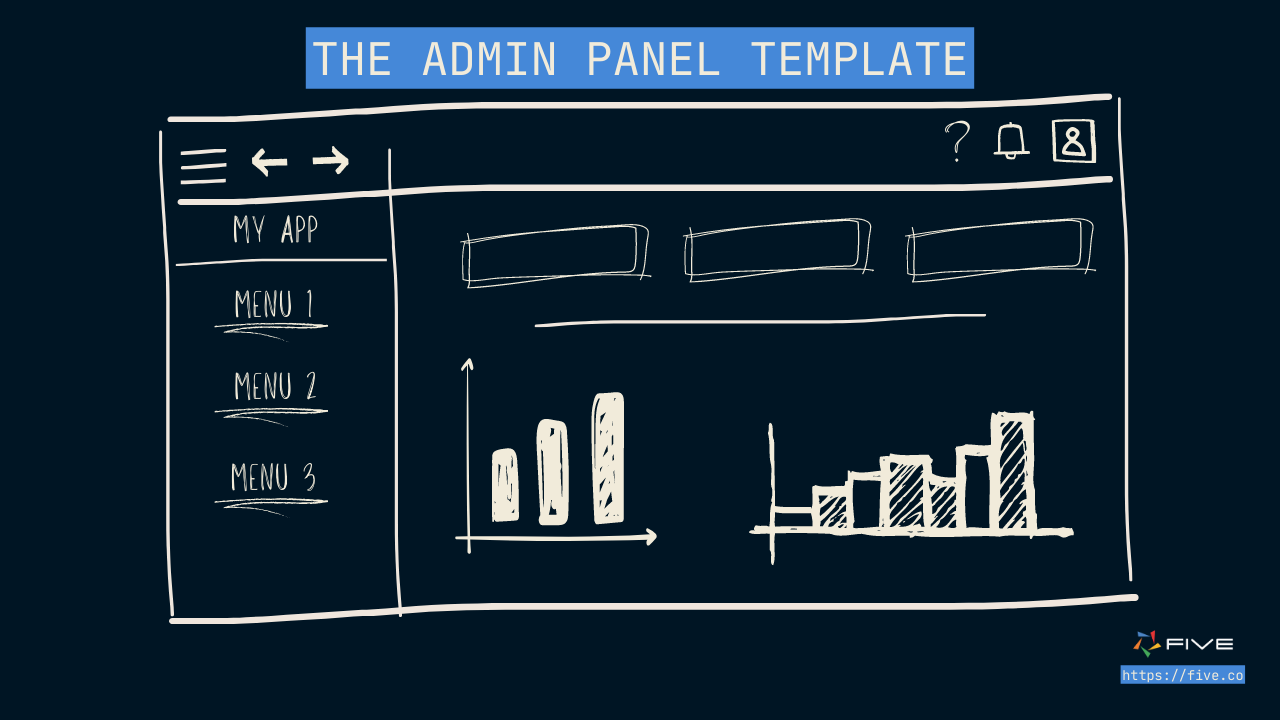The Best React-admin Tutorial
Follow This React-admin Tutorial and Learn How to Rapidly Create an Admin Panel
React-admin is an open-source React framework for B2B apps. Developers choose React-admin because of its great developer experience, comprehensive features, and ease of use. Tailor-made for the rapid development of admin panels and dashboards, React-admin provides developers with all the boilerplate code required to quickly build internal tools, dashboards, and custom B2B apps.
Reading this blog post and watching the React-admin tutorial will teach you the steps required to rapidly build and launch an admin panel.
Who This Article Is For
This article is for all developers whose next web application is supposed to look something like the wireframe below and who would like to develop an admin panel quickly.
PS: Scroll down to the React-admin tutorial below to get started right away.

What is React-admin?
React-admin is a popular open-source framework built on top of React. It is specifically designed for creating admin panels, dashboards, and internal tools for B2B applications. It abstracts away much of the complexity that comes with building user interfaces for managing data, providing a ready-made foundation that allows you to focus on your application’s core features rather than the boilerplate.
With React-admin, you get pre-built components like tables, forms, filters, and charts, all optimized for data-heavy applications. It supports REST and GraphQL out of the box, making it easy to connect to various APIs. Its extensible architecture allows developers to customize components or even create their own, ensuring that the admin panel can match any specific needs.
Whether you’re managing data from an API, setting up CRUD operations, or building complex user workflows, React-admin provides the tools and structure you need to do it quickly and effectively.
Following this React-admin tutorial, you’ll learn how to leverage these features and build a fully functional admin panel that integrates seamlessly with your backend.
Five: The Fastest Way to Build Admin Panels
There are even faster ways to build and launch admin panels web apps than React-admin.
Five, a cloud IDE, is a rapid application development environment designed to speed up the process of building and deploying admin panels on nearly any data source.
For developers, the beauty of Five lies in its ability to drastically reduce development time while offering robust functionality – without compromising on flexibility or control.
What makes Five stand out for admin panel development? Let’s break it down:
Auto-Generated Admin Panels:
Five can instantly generate an admin panel that connects to almost any data source, whether it’s a database or an API. You won’t need to manually code from scratch or worry about building complex backend integrations—Five takes care of that.
Database Modeler for MySQL:
With Five’s intuitive database modeling tool, you can design and manage your database schema directly in the platform, making it easy to create and modify tables without jumping between different environments.
Connection Wizard:
Need to pull data from an external REST API or connect to a different database? Five’s connection wizard simplifies the process of integrating external data sources, making complex integrations straightforward.
Form, Chart, and Report Wizards:
These tools allow you to quickly build forms for data collection, charts for data visualization, and reports for insight generation—all within a few clicks. Gone are the days when you needed to pull in Charts.JS or jsreport to get this done.
Out-of-the-Box Security:
Five includes built-in authentication and authorization, complete with advanced features like Multi-Factor Authentication (MFA) and Single Sign-On (SSO). This takes the headache out of managing user access and security, a common pain point when building an admin panel.
Audit Trail & Logs:
Five’s audit trail and logging features allow you to track every action taken within the admin panel, making it easy to monitor system changes and ensure accountability.
Built-in Debugger & Event-Driven Programming:
Debugging is seamless with Five’s built-in debugger, while its support for event-driven programming gives you control over your application’s behavior at critical moments.
Single-Click Deployment:
Whether you’re testing in development or launching in production, Five offers single-click deployment to pre-configured environments, meaning you can go from build to launch with minimal friction.
The best part? No external tools required. Five provides everything you need, from database modeling to deployment, all within a single platform. All development happens right in your browser, allowing for real-time collaboration with your team or solo coding sessions.
Five covers the entire admin panel development lifecycle, letting you focus on delivering a polished, powerful solution without worrying about the usual development overhead.
Admin Panel Tutorial: Build and Deploy an Admin Panel in Minutes
In this admin panel tutorial, you will learn step-by-step how to create a fully functional admin panel using Five. Whether you are starting from scratch or integrating with an existing project, this hands-on guide will walk you through everything you need to build a powerful admin interface in no time.
Here’s what you’ll achieve by the end of this tutorial:
Database Creation:
We’ll start by creating a database from scratch using Five’s built-in MySQL modeler, so you can manage and structure your data with ease.
Auto-Generated Admin Panel:
With your database ready, you’ll instantly generate an admin panel that includes essential features like forms for data collection, interactive charts for visualization, and a PDF report generator.
User Management & Authentication:
Learn how to add user management and authentication features to control who accesses your admin panel.
Third-Party Integration:
Finally, you will integrate your admin panel with external services like Slack, giving your application the ability to send real-time notifications and alerts.
What Developers Say About Five
Here is what users say about Five:
“Five is a great product for building admin panels or CRUD applications. It is easy to use, scalable and has great customer support. I highly recommend Five to anyone who needs to build a web application without much effort.” – Shweta Kale, Software Developer
“Five is an excellent approach to that disconnect between relational database development and the web.” – Crag Jones
“Five took away a lot of headaches of frontend development by providing a highly customizable UI and navbar alongside a MySQL database.” – Nebiyu Elias, Software Engineer
“With Five, we were able to very quickly develop a prototype of the solution we had in mind. We liked the fact that inside Five, we can work in no code, low code, or even full code, which gives us full flexibility to design software applications.” – Kurt Bornhutter, Group Manager, Revenue & Optimisation, Canstar
“Five is a rapid, robust way to take spreadsheet-based business processes, and replace them with better validated forms for data collection, and approval workflows. Five makes it easy to write custom functions, and perform traditional integrations, using JavaScript.” – Philip Antrobus, Data & AI Capability Lead, NCS Australia
React-Admin Tutorial: Setting Up a Basic React-admin Application
To set up a basic React-admin application, start by using React as the foundation. Bootstrap a new web application using the command npm init react-admin test-admin or yarn create react-admin test-admin.
During the setup process, select JSON Server as the data provider and choose None for the authentication provider. Skip adding any initial resources, and proceed by selecting either npm or yarn.
After the installation completes, navigate to your project directory with cd test-admin and run the development server using npm run dev or yarn dev. This will start an empty React-admin application running on port 5173.
React-admin applications are single-page apps (SPAs) that fetch data from APIs. To handle communication with the API, React-admin uses a Data Provider, which acts as an adapter. Use a mock REST API, such as JSONPlaceholder, as the data source, making it ideal for testing and prototyping.
To connect the API data to the React-admin app, map API endpoints using resources. The <Admin> component in React-admin expects <Resource> child components, each of which links a name to an API endpoint.
To add a list of users, for instance, edit the App.tsx file to include a <Resource> for users, allowing the admin panel to interact with the specified API endpoint.
With these steps, you’ll have a foundational React-admin app that can be expanded with additional features and data resources.
Watch the full React-admin tutorial here:
The Best React-admin Tutorial: A Step-by-Step Guide
This blog post provides a comprehensive guide to building an admin panel using React-admin, an open-source framework tailored for creating B2B apps and dashboards, and Five, a cloud IDE.
By following this React-admin tutorial, you’ve learned how to quickly set up a robust admin panel tailored for B2B applications. We walked through the process of bootstrapping a new React-admin app, connecting it to a data source using a Data Provider, and mapping API endpoints with resources. With this foundation, you can now expand and customize your admin panel to suit your application’s needs.
React-admin’s ease of use, combined with its flexibility, makes it a powerful choice for building efficient, data-driven dashboards and internal tools.
Happy coding, and enjoy building your next great admin interface!
Continue developing by following our comprehensive code-along articles here.
